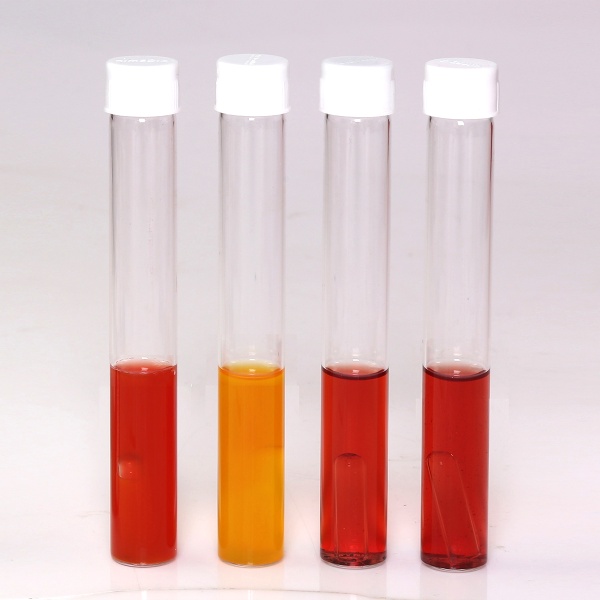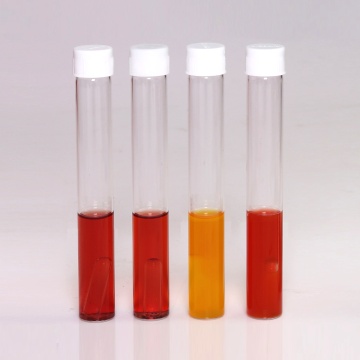 Your enquiry has been submitted
Your enquiry has been submitted
MacConkey Broth w/ Neutral Red
Intended use
Recommended for selective enrichment and enumeration of coliforms.
Composition**
| Ingredients | g/L |
|---|---|
| Peptone | 20.000 |
| Lactose | 10.000 |
| Bile salts | 5.000 |
| Sodium chloride | 5.000 |
| Neutral red | 0.075 |
| Final pH (at 25°C) | 7.4±0.2 |
**Formula adjusted, standardized to suit performance parameters
Directions
Suspend 40.07 grams in 1000 ml purified/ distilled water. Heat if necessary to dissolve the medium completely. Distribute into tubes with inverted Durhams tubes. Sterilize by autoclaving at 15 lbs pressure (121°C) for 15 minutes. Cool the tubes before inoculation.
Principle And Interpretation
MacConkey Broth is widely used as a differential medium for detection and enumeration of coliforms from a wide variety of food and water samples. Identification is based on colour change of the medium due to the indicator neutral red used (1,2).
Peptone provides necessary nitrogen source. Lactose serves as the fermentable carbohydrate source. Sodium chloride maintains the osmotic balance of the cells. The selective action of these media is attributed to the presence of bile salts, which are inhibitory to most species of gram-positive bacteria. Gram-negative bacteria usually grow well on these media and are differentiated by their ability to ferment lactose. The colour change of the medium shown by lactose-fermenters is due to production of acid from lactose and a subsequent colour change of the indicator dye when the pH of the media falls below 6.8. Lactose non-fermenting strains, such as Shigella and Salmonella do not alter the appearance of the medium. The medium turns pink in case of lactose fermenters and yellow in case of non-lactose-fermenters, due to neutral red. MacConkey Broth, which contains neutral red as an indicator is considered as a standard medium for the primary isolation as well as presumptive identification of coliform-aerogenes group of organisms in food and water.
Type of specimen
Food and dairy samples; Water samples.
Specimen Collection and Handling:
For food and dairy samples, follow appropriate techniques for sample collection and processing as per guidelines (3,4,5). For water samples, follow appropriate techniques for sample collection, processing as per guidelines and local standards. (6) After use, contaminated materials must be sterilized by autoclaving before discarding.
Warning and Precautions :
Read the label before opening the container. Wear protective gloves/protective clothing/eye protection/ face protection. Follow good microbiological lab practices while handling specimens and culture. Standard precautions as per established guidelines should be followed while handling specimens. Safety guidelines may be referred in individual safety data sheets.
Limitations :
- Individual organisms differ in their growth requirement and may show variable growth patterns on the medium.
- Each lot of the medium has been tested for the organisms specified on the COA. It is recommended to users to validate the medium for any specific microorganism other than mentioned in the COA based on the user's unique requirement.
- Further biochemical and serological test are necessary for confirmation.
Performance and Evaluation
Performance of the medium is expected when used as per the direction on the label within the expiry period when stored at recommended temperature.
Quality Control
Appearance
Pale yellow to pink homogeneous free flowing powder
Colour and Clarity of prepared medium
Red coloured clear solution without any precipitate
Reaction
Reaction of 4.01% w/v aqueous solution at 25°C. pH: 7.4±0.2
pH
7.20-7.60
Cultural Response
Cultural characteristics observed after an incubation at 35-37°C for 18-24 hours.
| Organism | Inoculum (CFU) | Growth | Acid | Gas |
|---|---|---|---|---|
| # Klebsiella aerogenes ATCC 13048 (00175*) | 50-100 | luxuriant | positive reaction | positive reaction |
| Escherichia coli ATCC 25922 (00013*) | 50-100 | luxuriant | positive reaction | positive reaction |
| Klebsiella pneumoniae ATCC 13883 (00097*) | 50-100 | luxuriant | positive reaction | positive reaction |
| Proteus mirabilis ATCC 25933 | 50-100 | luxuriant | negative reaction | negative reaction |
| Staphylococcus aureus subsp. aureus ATCC 25923 (00034*) | >=104 | inhibited | ||
| Enterococcus faecalis ATCC 29212 | 50-100 | none-poor |
Key:* - corresponding WDCM numbers
# - Formerly known as Enterobacter aerogenes
Storage and Shelf Life
Store between 10-30°C in a tightly closed container and the prepared medium at 15-30°C. Use before expiry date on the label. On opening, product should be properly stored dry, after tightly capping the bottle in order to prevent lump formation due to the hygroscopic nature of the product. Improper storage of the product may lead to lump formation. Store in dry ventilated area protected from extremes of temperature and sources of ignition Seal the container tightly after use. Use before expiry date on the label. Product performance is best if used within stated expiry period.
Disposal
User must ensure safe disposal by autoclaving and/or incineration of used or unusable preparations of this product. Follow established laboratory procedures in disposing of infectious materials and material that comes into contact with sample must be decontaminated and disposed of in accordance with current laboratory techniques (7,8).
Reference
- MacConkey A. T., 1900, The Lancet, ii: 20.
- MacConkey A. T., 1905, J. Hyg. 5: 333.
- American Public Health Association, Standard Methods for the Examination of Dairy Products, 1978, 14th Ed., Washington D.C.
- Salfinger Y., and Tortorello M.L. Fifth (Ed.), 2015, Compendium of Methods for the Microbiological Examination of Foods, 5th Ed., American Public Health Association, Washington, D.C.
- Wehr H. M. and Frank J. H., 2004, Standard Methods for the Microbiological Examination of Dairy Products, 17th Ed., APHA Inc., Washington, D.C.
- Lipps WC, Braun-Howland EB, Baxter TE,eds. Standard methods for the Examination of Water and Wastewater, 24th ed. Washington DC:APHA Press; 2023.
- Isenberg, H.D. Clinical Microbiology Procedures Handbook 2nd Edition.
- Jorgensen, J.H., Pfaller, M.A., Carroll, K.C., Funke, G., Landry, M.L., Richter, S.S and Warnock., D.W. (2015) Manual of Clinical Microbiology, 11th Edition. Vol. 1.
| Product Name | MacConkey Broth w/ Neutral Red |
|---|---|
| SKU | M007 |
| Product Type | Regular |
| Physical Form | Powder |
| Origin | Animal |
| Packaging type | HDPE |
| References | 1.MacConkey A. T., 1900, The Lancet, ii: 20. 2.MacConkey A. T., 1905, J. Hyg. 5: 333. 3.American Public Health Association, Standard Methods for the Examination of Dairy Products, 1978, 14th Ed., WashingtonD.C. 4.Salfinger Y., and Tortorello M.L. Fifth (Ed.), 2015, Compendium of Methods for the Microbiological Examination ofFoods, 5th Ed., American Public Health Association, Washington, D.C. 5.Baird R.B., Eaton A.D., and Rice E.W., (Eds.), 2015, Standard Methods for the Examination of Water andWastewater, 23rd ed., APHA, Washington, D.C. 6.Isenberg, H.D. Clinical Microbiology Procedures Handbook. 2nd Edition. 7.Jorgensen,J.H., Pfaller , M.A., Carroll, K.C., Funke, G., Landry, M.L., Richter, S.S and Warnock., D.W. (2015)Manual of Clinical Microbiology, 11th Edition. Vol. 1. 8.Wehr H. M. and Frank J. H., 2004, Standard Methods for the Microbiological Examination of Dairy Products, 17th Ed.,APHA Inc., Washington, D.C. |
| Customized Product Available | No |








